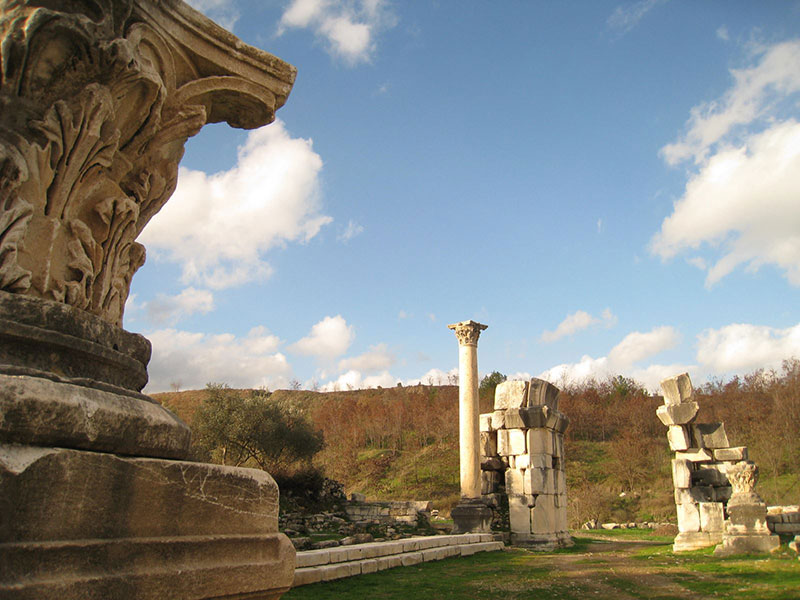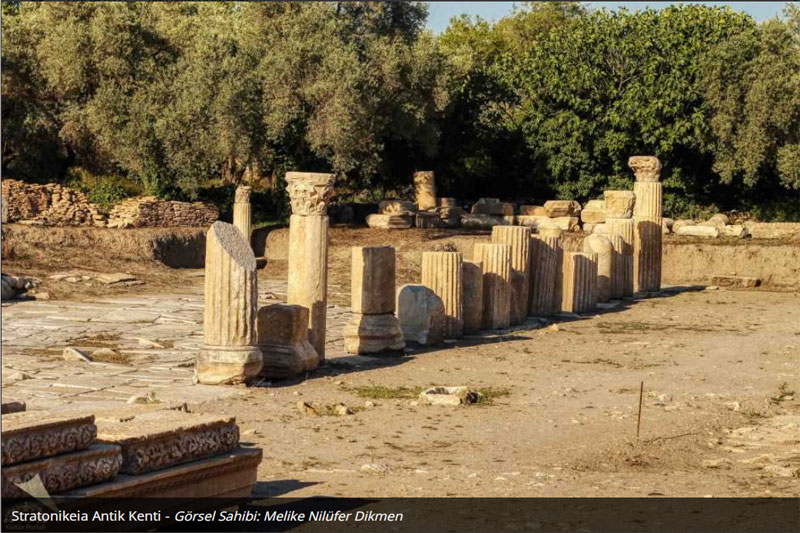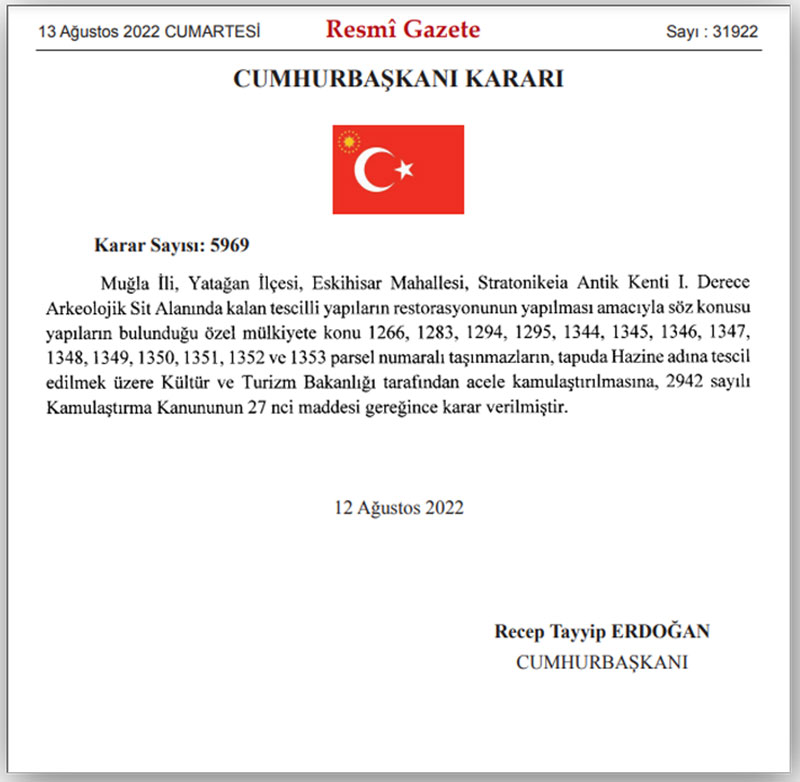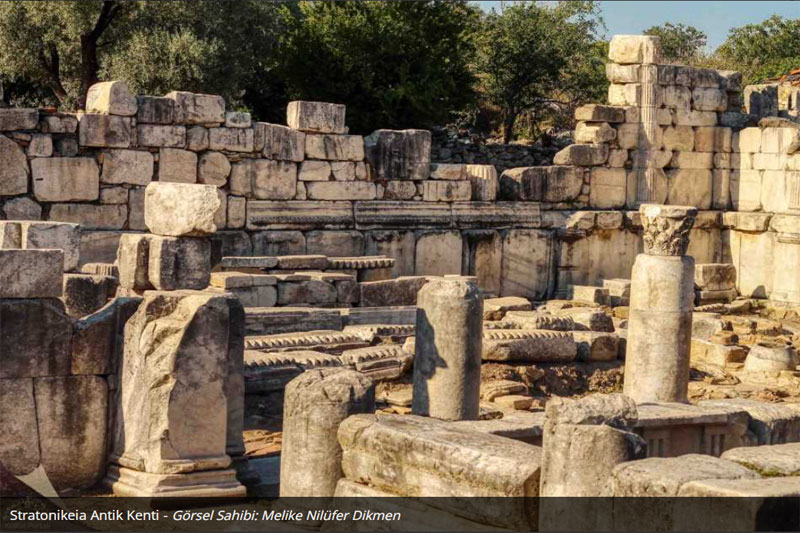
HABER
Yatağan Stratonikeia antik kenti için kararname
Türkiye'de ilk kez oluyor

Gümüşlük Haber Ajansı (GHA) - 15 Ağustos 2022 - Yatağan Stratonikeia antik kentindeki özel mülkler için Türkiye'de ilk defa Cumhurbaşkanlığı Kararnamesi ile kamulaştırma kararı çıkartıldı.
Türkiye'de ilk defa Cumhurbaşkanlığı Kararnamesi ile bir antik kentin sınırları içinde kalan özel mülkler için "acele kamulaştırma" kararı çıkartıldı. Davalarla işleyen sürecin uzaması ve çalışmaların yarım kalmaması için çıkartıldığı belirtilen "Acele Kamulaştırma" kararnamesi 13 Ağustos 2022 sayılı Resmi Gazete'de yayımlandı.
Gladyatörler kenti olarak da bilinen dünyanın en büyük mermer kenti olan, Yatağan Stratonikeia Antik Kentindeki kazı ve kazandırma çalışmaları sürüyor. Çalışmalar, Kültür ve Turizm Bakanlığı, Muğla Valiliği, kurumlar ve çok sayıda özel sektör kuruluşunun sponsorluğunda devam ediyor.
Geçmişi milattan önce 3'üncü yüzyıla kadar dayanan Helenistik dönem, Roma ve Bizans'ın yanı sıra Anadolu beylikleri, Osmanlı ve Cumhuriyet dönemleri için de önem taşıyan Stratonikeia Antik Kenti, Yatağan İlçesi'nin 6-7 kilometre batısındaki Yatağan-Milas karayolu üzerinde Eskihisar Köyü sınırları içerisinde yer alıyor.

Yatağan Stratonikeia antik kenti
Türkiye'de ilk
Antik kentin sınırları içinde kalan özel mülkler ile ilgili yapılan kamulaştırma çalışmalarının iddialara göre uzaması üzerine, Türkiye'de ilk defa Cumhurbaşkanlığı kararnamesi ile bir antik kent kazı alanında "Acele Kamulaştırma" kararı alındı.
13 Ağustos 2022 sayılı Resmi Gazete'de yayımlanan Cumhurbaşkanlığı Kararnamesinde şu bilgiler yer aldı;
"Muğla İli, Yatağan ilçesi, Eskihisar Mahallesi Stratonikeia antik kenti 1. Derece arkeolojik sit alanında kalan tescilli yapıların restorasyonunun yapılması amacıyla söz konusu yapıların bulunduğu özel mülkiyete konu 1266, 1283, 1294, 1295, 1344, 1345, 1346, 1347, 1348, 1349, 1350, 1351, 1352 ve 1353 parsel numaralı taşınmazların, tapuda hazine adına tescil edilmek üzere Kültür ve Turizm Bakanlığı tarafından acele kamulaştırmasına, 2942 sayılı kamulaştırma kanununun 27'nci gereğince karar verilmiştir."

13 Ağustos 2022 sayılı Resmi Gazete'de yayımlanan Cumhurbaşkanlığı kararnamesi
Stratonikeia antik kenti girişindeki eski yapılardan 14 parselde gerçekleştirilecek acele kamulaştırma işlemi sonrası bu alanlarda bulunan dükkanlarda restore ve konservasyon çalışmaları yürütülerek bu dükkanlar unutulmaya yüz tutmuş mesleklerin faaliyetlerini yürütebilecekleri alanlar haline getirilecek.
Stratonikeia Antik Kenti
Stratonikeia Antik Kenti, Muğla'nın Yatağan İlçesi'nin 6-7 km. batısındaki Yatağan-Milas karayolu üzerindeki Eskihisar Köyü sınırları içerisindedir. Kent, M.Ö. 3. yüzyılda kurulmuştur. Suriye Kralı I. Seleukos eşi Stratonike'yi oğlu Antiokhos'a verdi. Antiokhos da önce üvey annesi sonra eşi olan Stratonike adına kent kurdu. Gezgin ve yazar Strabon'a göre kent, çok güzel yapılarla donatılmıştı. Yapılan kazılarda ele geçirilen sikkelerden, Stratonikeia sikkelerinin Rhodos'tan bağımsızlığını kazandığı M.Ö. 167'den itibaren basılmaya başlandığı ve Gallienus (M.S.253-268) zamanına kadar devam ettiği anlaşılıyor.
Kentin akropolü güneydeki dağın tepesindedir. Bu tepenin çevresi bir surla çevrilmiştir. Kuzeyinde, yamaç üzerindeki bir teras üzerinde şimdiki karayolunun hemen altındaki, bir yazıtta imparator için yapılmış küçük bir tapınağın kalıntıları göze çarpar. Bunun aşağısında da büyük bir tiyatro vardır. Burada cavea, merdivenlerle 9 cuneusa bölünmüştür ve tek diazoma vardır. Sahne binasının kalıntıları, yapılan kazılarda büyük ölçüde ortaya çıkarılmıştır.
Antik kent üzerinde günümüzde terkedilmiş Eskihisar Köyü bulunmaktadır. Kent surlarla çevrilmiş olup, bugün kent surlarının yalnızca önemsiz uzantıları görülmektedir. Yerleşim alanının kuzeydoğu köşesinde, büyük kesme taşlar ile kireç harçtan örülmüş güçlü bir kalenin yıkıntıları vardır. Yapı, büyük kesme taşlar ile kireçli harçtan örülmüştür. Yapının onarım gördüğü diğer yapılardan alınma yazıtlı taşlar ve sütun gövdelerinden anlaşılmaktadır.

Yatağan Stratonikeia antik kenti
Kentin kuzey kenarındaki ana giriş kapısı büyük bloklardan oluşmaktadır. Geniş ve ince taş duvarcılığı ile örülmüştür. Bu kapının üzerinde kemer olduğu kalıntılardan anlaşılmaktadır. Kapı iki girişlidir. İki kapı girişi arasında bir nymphaion vardır. Kapıdan sonra sütunlu bir alanın ve yolun varlığı görülmektedir. Kentin tam ortasında, en çok göze çarpan yapısı, kent meclisinin toplandığı bouleuterion bulunmaktadır.
Bouleuterion tiyatro benzeri küçük bir yapıdır. Bu yapının hemen batısındaki tek başına duran kapı bu alanın giriş kapısıdır. Bunun Serapis Tapınağı olduğu ileri sürülmüştür; ancak kazılarda bulunan yazıtlar bu görüşün yanlış olduğunu göstermiştir. Bouleuterionun kuzeye bakan dış duvarında Diocletianus'un fiyat listesi ve bunun uygulanmasına ilişkin giriş kısmı Latince yazılmıştır. Bu yapının alttaki oturma sıraları korunmuştur.
Kentin batısında, Antik Yunan ve Roma'da gençlerin düşünsel ve bedensel yönden eğitildikleri, öğrenim gördükleri, spor etkinliklerinde bulundukları gymnasion denilen yapı bulunmaktadır. Kente giriş kapısının önündeki kutsal yolun kenarında oda mezarlar yer almaktadır. Giriş kapısından başlayan kutsal yol nekropolden geçmekte ve Lagina'daki Hekate kutsal alanına ulaşmaktadır. Söz konusu nekropol sahası günümüzde kömür ocakları havzası altında kalarak yok olmuştur.
Görseller ve bilgi "Türkiye Kültür Portalı"ndan alıntıdır.
Kaynak: https://www.kulturportali.gov.tr/turkiye/mugla/gezilecekyer/stratonikeia-antik-kenti
Expropriation decision in the ancient city
With the Presidential Decree, the expropriation decision was made for the private properties in the ancient city of Yatağan Stratonikeia.
For the first time in Turkey, with the Presidential Decree, an "urgent expropriation" decision was made for private properties within the borders of an ancient city. The "Immediate Expropriation" decree, which is stated to have been issued due to the prolongation of the process with the lawsuits, was published in the Official Gazette No. 13 August 2022.
Excavation and restoration work in the ancient city of Yatağan Stratonikeia, the world's largest marble city, also known as the city of gladiators, continues. The studies continue with the sponsorship of the Ministry of Culture and Tourism, Muğla Governorship, institutions and many private sector organizations.
Stratonikeia Ancient City, which is important for the Hellenistic period, Roman and Byzantine as well as Anatolian principalities, Ottoman and Republican periods, dating back to the 3rd century BC, is located in Eskihisar Village on the Yatağan-Milas highway, 6-7 kilometers west of Yatağan District. located within its borders.
Due to the alleged prolongation of the expropriation works for the private properties within the borders of the ancient city, the decision of "Immediate Expropriation" was taken in an ancient city excavation site for the first time in Turkey with a presidential decree.
The following information was included in the Presidential decree published in the Official Gazette No. 13 August 2022;
"In order to restore the registered structures remaining in the 1st degree archaeological site of the ancient city of Stratonikeia, in the Yatağan district of Muğla, in Eskihisar Mahallesi, 1266, 1283, 1294, 1295, 1344, 1345, 1346, 1347, 1348, 1349, which are subject to private property where the said structures are located In accordance with the 27th article of the expropriation law numbered 2942, it was decided to expropriate the immovables with parcel numbers 1350, 1351, 1352 and 1353 by the Ministry of Culture and Tourism in order to be registered in the name of the treasury in the land registry.

Stratonikeia Ancient City
After the urgent expropriation process to be carried out on 14 parcels of the old buildings at the entrance of the ancient city of Stratonikeia, restoration and conservation works will be carried out in the shops located in these areas, and these shops will be turned into areas where the professions that are about to be forgotten can carry out their activities.
Stratonikeia Ancient City
Stratonikeia Ancient City is located 6-7 km from Yatağan District of Muğla. It is within the borders of Eskihisar Village on the Yatağan-Milas highway to the west of it. Kent, BC. It was founded in the 3rd century. King of Syria Seleukos I gave his wife Stratonike to his son Antiochus. Antiochus also founded a city in the name of Stratonike, who was first his stepmother and then his wife. According to the traveler and writer Strabon, the city was equipped with very beautiful structures. From the coins found in the excavations, Stratonikeia coins gained their independence from Rhodes in the BC. It is understood that it started to be printed from 167 and continued until the time of Gallienus (253-268 AD).
The acropolis of the city is on the top of the mountain in the south. This hill is surrounded by a wall. To the north, on a terrace on the slope, just below the current highway, there are the remains of a small temple built for the emperor in an inscription. There is also a large theater below it. Here, the cavea is divided into 9 cunei by stairs and there is a single diazoma. The remains of the stage building were largely unearthed during the excavations.
There is the abandoned Eskihisar Village on the ancient city. The city was surrounded by walls, and today only minor extensions of the city walls are visible. In the northeast corner of the settlement are the ruins of a strong castle built of large cut stones and lime mortar. The building was built of large cut stones and lime mortar. It is understood from the inscribed stones and column bodies taken from other buildings that the building was repaired.
The main entrance gate on the northern side of the city consists of large blocks. It was built with wide and thin stone masonry. It is understood from the remains that there was an arch on this door. The door has two entrances. There is a nymphaion between the two gate entrances. After the door, the presence of a columned area and a road can be seen. In the middle of the city, the most striking structure is the bouleuterion, where the city council met.
The Bouleuterion is a small theatre-like building. The stand-alone door just to the west of this building is the entrance to this area. It has been suggested that this was the Temple of Serapis; however, the inscriptions found in the excavations showed that this view was wrong. On the north-facing outer wall of the bouleuterion, Diocletian's price list and the introduction to its implementation are written in Latin. The lower benches of this building have been preserved.
To the west of the city, there is a building called gymnasion, where young people in Ancient Greece and Rome were educated intellectually and physically, studied and participated in sports activities. There are chamber tombs on the side of the sacred road in front of the entrance to the city. The sacred road starting from the entrance gate passes through the necropolis and Hecate reaches her sanctuary. The necropolis area in question has been destroyed by being under the coal mines basin today.
Images and information are taken from "Turkey Culture Portal".
Source: https://www.kulturportali.gov.tr/turkiye/mugla/gezecekyer/stratonikeia-antik-kenti
TAGS;


































































